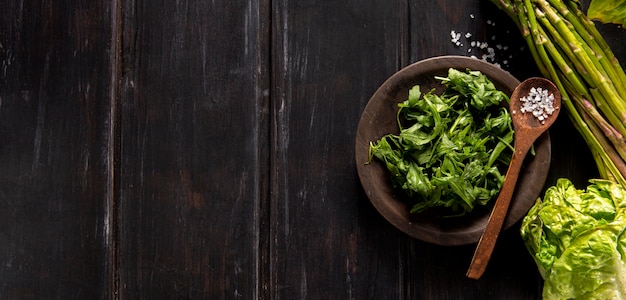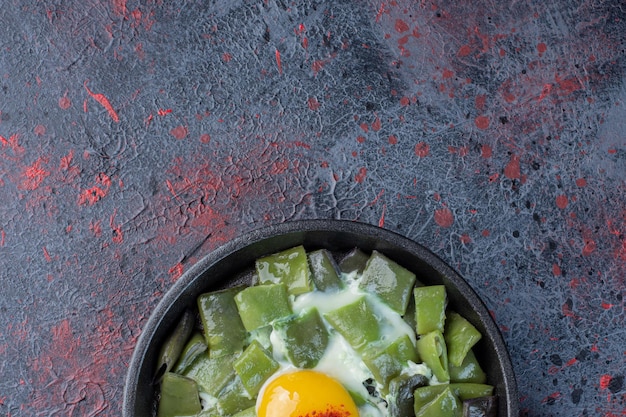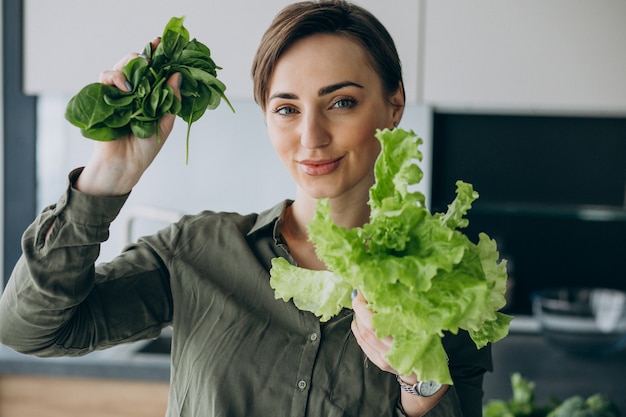(Part 1) The Basics: Choosing and Prepping Kale

Choosing the Right Kale
First things first, let's talk about choosing the right kale. This is a crucial step that can make or break your dish. Look for kale with vibrant green leaves that are firm and crisp. Avoid any kale that looks wilted, has brown spots, or feels limp. Personally, I adore the flavor of curly kale. It has that classic crinkled texture and a slightly peppery taste that I find incredibly satisfying. But don't be afraid to experiment with other varieties like lacinato kale (also known as dinosaur kale). It has a milder flavor, and its long, flat leaves are perfect for making chips.Prepping Kale for Cooking
Now that you've got your kale, it's time to prep it. This is where a lot of people get stuck, so let's break it down:1. Wash It Thoroughly: Give your kale a good rinse under cold running water to get rid of any dirt or debris.2. Strip the Stems: The tough stems are a bit of a nuisance. You can remove them by cutting them off with a knife or by holding the stem and pulling the leaves off with your fingers. This might seem like a chore, but trust me, it makes a world of difference in the texture of your dish.3. Chop It Up: Once you've stripped the leaves, chop them into whatever size you prefer. I generally chop them into 1-inch pieces, but feel free to go smaller or larger, depending on your dish.(Part 2) The Secret to Tender Kale

Massage, Massage, Massage
Yes, you heard that right. Massaging kale is a game-changer! The gentle process of massaging the kale leaves with a bit of oil and salt breaks down the tough fibers, making them softer and more tender. 1. Start with a good oil: I typically use olive oil, but feel free to experiment with other oils like avocado oil or sesame oil.2. Add a Pinch of Salt: Salt helps to draw out moisture, contributing to the tenderizing process.3. Massage it: Use your hands to gently massage the oil and salt into the kale leaves. This should take about 1-2 minutes.Don't Overcook it
One of the biggest mistakes people make when cooking kale is overcooking it. Think of it like a delicate flower—you need to treat it with care. Here's what I've learned: Sautéing: When sautéing kale, cook it over medium heat for just a few minutes. You want it to be wilted and tender but still have some bite. Boiling: If you're boiling kale, it only needs about 3-5 minutes. You'll know it's ready when it's bright green and wilted.The Magic of Acid
Adding a touch of acid to your kale while cooking can really brighten up the flavor and make it more palatable. A squeeze of lemon juice, a splash of vinegar, or even a drizzle of balsamic vinegar can work wonders.(Part 3) Crispy Kale Chips: A Healthy Snack Sensation

The Recipe
Crispy kale chips are a healthy and delicious snack that are perfect for movie nights, snack attacks, or even as a crunchy topping for salads. Here's how to make them: Ingredients: 1 bunch of curly kale 2 tablespoons olive oil 1/2 teaspoon salt 1/4 teaspoon black pepper Optional: 1/4 teaspoon garlic powder Instructions:1. Wash and Dry: Wash your kale thoroughly and pat it dry with paper towels. 2. Remove the Stems: Remove the tough stems from the leaves, leaving just the tender leaves. 3. Rip and Toss: Tear the kale leaves into bite-sized pieces. Toss them in a bowl with olive oil, salt, pepper, and garlic powder (if using).4. Spread and Bake: Spread the kale in a single layer on a baking sheet lined with parchment paper. Bake in a preheated oven at 350°F (175°C) for 10-15 minutes, or until crispy.Tips for Perfect Kale Chips
Don't Overcrowd the Baking Sheet: Make sure the kale is in a single layer so that it can crisp up evenly. Don't Overbake: Keep a close eye on the kale, as it can burn quickly. Experiment with Seasonings: Get creative! You can add other seasonings like paprika, cayenne pepper, or even a sprinkle of nutritional yeast for a cheesy flavour.(Part 4) Kale Smoothies: A Green and Delicious Start to Your Day
The Recipe
Kale smoothies are a fantastic way to sneak in your daily dose of greens. They are packed with nutrients, refreshing, and surprisingly delicious! Ingredients: 1 cup kale, roughly chopped 1/2 cup frozen fruit (such as berries, banana, or mango) 1/2 cup milk or plant-based milk (almond, soy, coconut) 1 tablespoon peanut butter or other nut butter 1/2 teaspoon honey or maple syrup (optional) 1/4 teaspoon vanilla extract Instructions:1. Blend It All: Combine all ingredients in a blender and blend until smooth.2. Adjust Consistency: If you want a thicker smoothie, add a bit more frozen fruit. If you want a thinner smoothie, add a little more milk or plant-based milk.Tips for Delicious Kale Smoothies
Use Frozen Fruit: Frozen fruit gives your smoothie a nice creamy texture and makes it extra refreshing. Don't Be Afraid to Experiment: Try different fruits, milk options, and sweeteners to find your perfect blend. Add a Boost of Protein: Add a scoop of protein powder for an extra dose of protein.(Part 5) Kale Salad: A Light and Refreshing Meal
The Recipe
Kale salads are a great choice for a light and healthy meal. They are incredibly versatile and can be customized to your taste. Ingredients: 1 bunch of curly kale, roughly chopped 1/2 cup cherry tomatoes, halved 1/4 cup red onion, thinly sliced 1/4 cup crumbled feta cheese 2 tablespoons olive oil 1 tablespoon lemon juice 1/2 teaspoon salt 1/4 teaspoon black pepper Instructions:1. Wash and Chop: Wash your kale thoroughly and chop it into bite-sized pieces.2. Combine: In a large bowl, combine the kale, cherry tomatoes, red onion, and feta cheese.3. Dress It Up: In a small bowl, whisk together the olive oil, lemon juice, salt, and pepper. Pour the dressing over the salad and toss to combine.Tips for a Great Kale Salad
Massage the Kale: Massaging the kale with a bit of olive oil and salt will make it more tender. Add a Crunch: Add some crunchy elements to your salad, like toasted nuts, seeds, or croutons. Get Creative with Toppings: Don't be afraid to add other vegetables, fruits, or even roasted chickpeas to your salad.(Part 6) Kale Soups: Warming and Comforting
The Recipe
Kale soup is a hearty and comforting meal, perfect for chilly evenings. It's a great way to use up leftover kale and can be customized with different ingredients and spices. Ingredients: 1 bunch of curly kale, roughly chopped 1 onion, chopped 2 carrots, chopped 2 celery stalks, chopped 4 cups vegetable broth 1/2 teaspoon salt 1/4 teaspoon black pepper 1/4 teaspoon dried thyme 1/4 cup heavy cream or milk (optional) Instructions:1. Sauté the Vegetables: In a large pot or dutch oven, sauté the onion, carrots, and celery in olive oil over medium heat for 5-7 minutes, or until softened.2. Add the Kale and Broth: Add the chopped kale and vegetable broth to the pot. Bring to a boil, then reduce heat and simmer for 15-20 minutes, or until the kale is tender.3. Season and Serve: Season the soup with salt, pepper, and thyme. If desired, stir in heavy cream or milk.Tips for the Perfect Kale Soup
Don't Overcook the Kale: Overcooked kale can become mushy. Use a Good Broth: A flavorful broth is key to a delicious soup. Add a Dash of Spice: Experiment with different spices, such as paprika, chili powder, or cumin.(Part 7) Kale in Other Dishes: Exploring the Possibilities
Kale Pasta
Kale can add a delicious and nutritious touch to your pasta dishes. Simply sauté some chopped kale with garlic and olive oil, then toss it with your favourite pasta and sauce. It works especially well with tomato-based sauces, pesto, and creamy sauces.Kale Risotto
Add a handful of chopped kale to your risotto in the last few minutes of cooking for a boost of flavor and colour. It pairs well with mushrooms and Parmesan cheese.Kale Pizza
Top your pizza with chopped kale for a healthy and flavourful twist. It complements both white and red sauce pizzas.(Part 8) FAQs
Q: Can I freeze kale?
Yes, you can freeze kale! Wash and dry your kale thoroughly, then chop it into pieces. Place the kale in a freezer-safe bag and squeeze out as much air as possible. Frozen kale can be stored for up to 3 months. It's a great way to have a stash of kale ready for smoothies or soups.
Q: What does kale taste like?
Kale has a slightly bitter and earthy taste. However, the bitterness can be mitigated by massaging it with oil and salt, or by cooking it with other flavourful ingredients. Think of it like a blank canvas that absorbs the flavours of the other ingredients.
Q: What are the nutritional benefits of kale?
Kale is a nutritional powerhouse! It is packed with vitamins, minerals, and antioxidants, including vitamin A, vitamin C, vitamin K, and calcium. It's a great source of fiber and is low in calories. It's a real winner for health-conscious foodies.
Q: How can I make kale less bitter?
You can reduce the bitterness of kale by massaging it with oil and salt, adding a touch of acid (like lemon juice or vinegar) while cooking, or combining it with other flavourful ingredients. Sweet ingredients like apples or pears can also balance out the bitterness.
Q: What are some other ways to cook kale?
Apart from the methods mentioned above, you can also try braising kale, roasting it in the oven, or even using it in stir-fries and curries. Get creative and explore the endless possibilities!
Everyone is watching

How to Cook Frozen Lobster Tails Perfectly: A Step-by-Step Guide
RecipesLobster. Just the word conjures up images of lavish meals, special occasions, and a taste of luxury. But let's...

Pigs in a Blanket Cooking Time: How Long to Bake for Perfect Results
RecipesAh, pigs in a blanket. Just the name conjures up images of those delightful little parcels of crispy pastry en...

Pork Fillet Cooking Time: How Long to Cook It Perfectly
RecipesPork fillet, or tenderloin as it's sometimes called, is a real favourite in our house. It's so versatile, and...

The Ultimate Guide to Cooking Delicious Frankfurters
RecipesLet's face it, we all love a good frankfurter. It's a classic, simple, and always satisfying. But let's be rea...

Wolf Meat Recipes: A Guide to Cooking Wild Game
RecipesLet's be honest, you don't see wolf meat at your local butcher shop every day. It's a bit of a wild card, but ...
